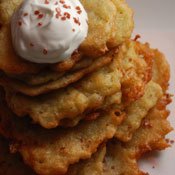Oil. It's in nearly everything we eat. We use spritzes of oil to sauté and roast, drizzles of it to toss with salads and puddles to deep fry, well, everything else. Oil is made from olives, corn, a variety of nuts and soybeans. It is an essential fat we love to consume. And for eight days, usually in December, oil is the thing we remember, the thing we honor for Hanukkah.
The nutshell version of Hanukkah is this: The Maccabees, an army of Jewish rebels, liberated parts of Israel from some pretty bad folk. The Maccabees came into Jerusalem went to rededicate the Temple, but found there was only enough consecrated oil to fuel the ner tamid (eternal flame) for one day. A miracle occurs when the oil burns for eight days while the Maccabees prepare more oil. To this day, Jews mark this historic event by lighting candles and reciting blessings, increasing the lights each night.
While most of us don't use oil anymore to fuel flames, quite a few of us still indulge in the deliciousness oil brings, and we do what southerners do best: fry.
Traditionally, Jews consume sufaganiyot, heavenly pockets of yeasty donut filled with jam, and latkes, the potato pancakes of which everyone is so fond. But Eight days of oil with a side of oil can get tiresome to your tummy, and leave you with a slick face and a potential flashback to the aches and pains you incurred at the state fair. Maybe it's time to think about baking with oil or adjusting what kind of oil you use.
Every kind of oil has a smoke point, meaning that every oil has a point that it can get too hot. For as long as I can remember, my mamaw has used vegetable oil for everything she fries or coats for cooking. If you want to go the healthier route, use olive oil (which is the kind of oil we're talking about in the Hanukkah story, anyway), but use the virgin or pure oil instead of extra virgin to capture the taste of the olive. Another oil I've become fond of using is safflower oilanother mild oil that can be used for sautéing and lightly frying things, like tofu, or when making pancakes.
Wait, use safflower oil when making pancakes? Who does that? I do. I'm a true southern cook when it comes to using butter. I typically will use Earth Balance margarine when heating in my skillet, but I also like the vitamin E I get from safflower oil. So I heat Earth Balance up before I pour my batter into the skillet. I'd rather have a light taste and be able to smother my cakes in agave syrup or fresh fruit than have butter running down my chin. Don't get me wrong: I love butter, just not all the time. Moderation is your key and, thankfully, you have options that would make the Maccabees proud. I think.
When preparing your holiday foods this season, whether for Hanukkah or not, consider substituting oil for butter and margarine. If you're already a member of the oil club, explore different kinds of oil to play with. There are some really lovely kinds of oils out there begging for use: pumpkin oil, is great for risotto; sesame oil is a wonderful companion to toasting brown rice; and walnut oil through high-priced, adds a richness to your foods.
Even when you're baking, you can substitute oil into your recipes, but make sure you do your research on which ones change the taste of your dish, and modify as needed with a dash more of cinnamon or fresh ginger. Oil and spices will be your stars this holiday season. Chag sameach!
Curried Potato Latkes
2 large russet potatoes, peeled & grated
1/2 cup shredded carrots
1/2 cup chopped cilantro
2 eggs, beaten
1 Vidalia onion, shredded
1 tablespoon sea salt
1 tablespoon curry powder
Olive oil for frying
Black pepper for taste
Sour cream or prepared fruit chutney
After potatoes are peeled and grated, dip in cold water and place in colander, straining out as much water as possible. Another method is to wrap up the grated potatoes in cheesecloth and squeeze out water. This is essential to get nicely browned latkes that are not greasy.
In a large bowl, mix together potatoes, carrots, onions and cilantro. Mix in egg, salt and curry powder until all mixture is coated. Pour oil into skillet until bottom is covered and heat to 350 degrees. If you don't have the right thermometer, you can always wait a minute and drop in a piece of potato. If it browns within a minute, you're ready, but keep your eye on the temperature.
Take up 1/4 cup of mixture and place into pan, flattening with a fork. Fry until sides are brown and then carefully flip and fry until all sides are crispy. Remove from oil and place on wire rack or on a baking sheet in a warm oven. Latkes should be served warm with a dollop of sour cream or fruit chutney.



Comments
Use the comment form below to begin a discussion about this content.
comments powered by Disqus